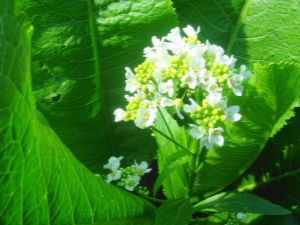Horseradish flowers: growth, collection and application

Despite the active development of modern medicine, folk recipes continue to be popular with many people in Russia, especially older ones. The use of medicines from our own garden is not only cheap, but also quite effective. One of the most widely used plants in folk medicine is horseradish, in which it is customary to process absolutely all parts for medicinal purposes: roots, leaves and flowers.
How does the plant bloom?
Horseradish begins to bloom from the end of the last spring month to mid-June, and sometimes July. It is important to mention that flowering begins only from the second year of culture. Revealing buds are transformed into bisexual flowers, decorated with neat white petals. Often people are surprised by the fact that their smell is very pleasant, because hell cannot boast of such a property. Individual inflorescences "bunch" together, creating something that looks like a branch of lilac.
In general, this crop is most often propagated using cuttings, but it also forms seeds. When flowering is completed, a plump round pod can be found on the plant, in which the seeds accumulate. At the end of the formation, the material can be used for propagation of the culture.
Horseradish blooms extremely rarely, usually in those areas where the roots are regularly dug. In order for this to happen, the culture must develop in the right conditions: with regular irrigation, constant heat and supplemental feeding as necessary. However, if such a situation is undesirable, then it is enough just to tear off the existing flowers, and just in case burn them.
What are the healing properties of flowers?
Treatment with horseradish flowers successfully manifests itself in many situations, from troubles with the gastrointestinal tract to kidney disease. In addition, it is believed that this part of the plant can even help patients with cancer - if not fully cope with the problem, then at least support the body and strengthen its protective ability. Such ability of horseradish as prevention of malignant tumors is also noted. You can also make tincture from flowers, the use of which gives energy and helps to better endure third-party troubles, for example, infectious diseases.
Horseradish flowers are often dried, and then selected as a component for medicinal decoctions. It should be mentioned that horseradish flowers perfectly clean the intestines from toxins and harmful microorganisms. In addition, the use of plants improves the functioning of the gastrointestinal tract, and the metabolism is accelerated. Horseradish has a beneficial effect on the condition of the oral cavity: teeth and gums.
Not to mention the stimulating effect of culture - judging by the reviews, even memory is changing for the better. There are also such interesting side effects as improving the reproductive abilities of the stronger sex, restoration of vision. Finally, horseradish helps fight alcohol and tobacco addiction.
By itself, the composition of the flowers horseradish is very saturated. It contains B vitamins, vitamin C, folic acid, flavonoids, polysaccharides and other important elements. Mustard oil contained in the composition allows to use horseradish for pain relief, flavonoids - to improve the condition of blood vessels, and fatty acids accelerate regenerating processes. Remembering potassium, copper, iron, manganese and other substances, it can be understood that horseradish flowers can affect all body systems.
Collection
Horseradish flowers are usually collected in the middle of the flowering period - at this moment this part of the plant accumulates the maximum amount of useful substances. However, it is worth remembering that while the buds are laid, they form a lot of biologically active components that can cause allergies.Therefore, before using horseradish for self-treatment, you must first consult with a specialist.
The collection is as follows: first, the arrows are cut off, in which it is impossible to break flowers, then the inflorescences are removed for drying to where the comfortable temperature is maintained, where it is dry and there is the possibility of airing. Usually, the flowers are dried for about fourteen days, but throughout this entire period, the plants should be checked and sifted to prevent rotting. When parts of the plant are dry, they can be separated from the arrow and stored for storage in a bag of linen.
Store dried inflorescences only in a dark and dry place. It is not recommended to use a plastic bag - over time, the flowers may begin to rot.
Useful recipes
It should begin with the fact that the flowers for medicinal purposes are used either in the form of alcohol tinctures, or tea, which would be good to add berries or lemon slices. They can be used both inside the body and externally. Traditional medicine recommends using these parts of horseradish to strengthen the immune system and recuperate.
The tincture is prepared on the basis of a flowering arrow, which will have to be thrown to the waning moon. The inflorescences are finely chopped, and then tightly placed in a jar of glass. It is important that there is space for liquid above. As the last applied forty-degree vodka. Capacity clogged and retracted for ten days. The finished tincture is used in the amount of a teaspoon, which is necessarily diluted in a cup of pure water.
In general, the standard tincture is prepared on the basis of vodka or forty percent ethyl alcohol, which can be bought at the pharmacy. Dried flowers are laid out in a glass jar or bottle. It should be mentioned that the glass should be dark, and the volume of the tank should vary from a liter to two.
Then the liquid is gently poured inside, but not directly on top, but along the wall of the can. When the container is filled, it can be closed with a lid. The medicine will have to be stored in a dark space where the rays of the sun do not flow. It is also important to shake the tincture from time to time. After about three weeks you can start using it even without straining.
Usually a teaspoon of tincture is stirred in a glass of pure chilled water. In addition, it can be added to freshly prepared medicinal teas, designed to invigorate and enhance the condition of the body. For example, it may be chamomile, calendula, or St. John's wort.
To prepare a healthy drink, first two teaspoons of dried herbs will need to be covered with a glass of hot water, brought to a boil and cook for a couple of minutes. Strained liquid is mixed with a teaspoon of horseradish tincture. It is recommended to take this medicine twice a day after meals in the amount of one mug. The length of the course varies from one to three months, depending on the goals and condition of the patient.
Tea of their horseradish flowers can be consumed fresh immediately after preparation. Usually a teaspoon of dried flowers is poured into the teapot, after which they are poured with a glass of water heated to 95 degrees Celsius. The kettle is closed with a lid, and the infusion is brewed for about thirty minutes. Drinking such a drink is no more than twice a day, and always after meals. Since the tea has a rather specific taste, it can be diluted with honey, berries, fruits or lemon.
How long the course will last usually depends on the purpose for which the tea is brewed. In the case of a tumor, horseradish is applied up to sixty days. If the usual preventive cleansing of the body is carried out, then you cannot drink tea for more than fourteen days. By the way, this drink can be used to wipe the skin.
Regular treatment will help to get rid of acne and post acne, acne, excessive pigmentation and other troubles.A great idea would be to freeze the cubes of tea and use them every morning. You can wipe not only the face, but the whole body. In addition, you can rinse your mouth with such an infusion after brushing your teeth. This will not only be a good prevention of diseases of the oral cavity, but also help to cope with such diseases as stomatitis.
Recommendations for use
It is important not to forget that horseradish applies to crops with irritating properties. This means that its use should be dosed and non-permanent. Care should be given to people suffering from peptic ulcers and gastritis caused by high acidity. Among the contraindications are also mentioned kidney disease. Of course, do not forget about individual intolerance and allergic reactions. Separately, it is worth recalling that horseradish flowers should not be used by pregnant women, nursing mothers and young children.
The infusion of horseradish flowers is especially recommended in the case when a person is sick with influenza, bronchitis or other related disease. You can simply take the medicine by mouth and also gargle about six times a day. The same tinctures will help in the case of dry cough, because the components of the flowers gradually dilute the sputum, allowing it to quickly be removed from the larynx and bronchi. It is recommended to combine the tincture on alcohol with decoctions of other medicinal cultures.
With dysentery, this plant will come to the rescue again - in its composition it has pectins, which have an absorbent property. The same applies to poisoning situations.
Since horseradish flowers are able to prevent the development of malignant tumors, people whose relatives were held hostage in this situation should drink alcoholic tincture as a prophylactic once a year for a month.
It would be nice to remember that horseradish tincture still contains alcohol, albeit in small quantities, so you need to be careful with driving a car for this time. Or, before using the tincture, it will need to be held in the open air so that the alcohol can completely disappear.
Rules of growing, collecting and storing horseradish are waiting for you in the video below.




























